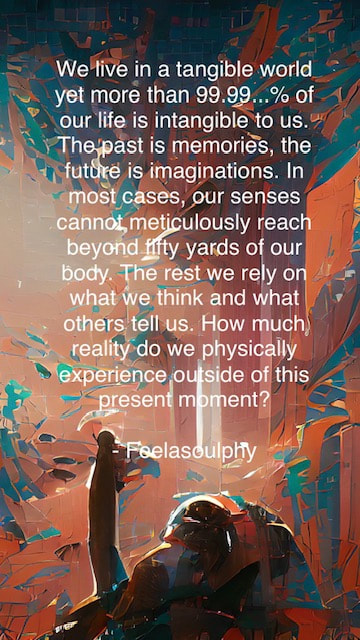|
Have you ever wondered how something as solid as a table or a rock can be made up of tiny particles and energy? Science tells us that what we perceive as solid is far from what it seems—and some theories even suggest our reality might be like a hologram. Let’s explore this fascinating idea in simple terms and touch on one of the most famous experiments that shakes up how we view reality: the double-slit experiment and quantum entanglement. Why Does Everything Feel Solid? Here’s the mind-blowing truth: everything in the universe is made of atoms, and atoms are about 99.999999% empty space! If they’re mostly empty space, why do things feel solid? It’s all about forces and energy: • Atoms are surrounded by electrons, tiny negatively charged particles. When two objects come into “contact,” their electrons repel each other because like charges repel. This creates an invisible force that keeps things from passing through each other. Imagine trying to push the negative ends of two magnests together-they resisit each other, creating an invisible force. The same thing happens at the atomic level when you touch an object! • What we perceive as “solidness” is really the sensation of this electromagnetic repulsion. So, solidity is an illusion created by energy interactions at the atomic level. Why Do Some Things Feel More Solid Than Others? Not everything feels equally solid because: 1. Density: Some materials, like metal, have atoms packed tightly together, creating more resistance when you touch them. Less dense materials, like foam, have more empty space between atoms, making them feel softer. 2. Bonds: Strong atomic bonds, like those in diamonds, make objects feel harder, while weaker bonds, like in rubber, allow objects to bend and feel less rigid. The Double-Slit Experiment: Does Reality Depend on Observation? Now let’s dive into an experiment that challenges how we understand reality: the double-slit experiment. 1. The Setup: • Imagine firing tiny particles (like electrons or photons) at a wall with two slits. • If no one observes them, these particles behave like waves, creating an interference pattern on the wall behind the slits. This pattern suggests that the particles travel through both slits simultaneously as a wave. 2. The Twist: • When scientists observe which slit the particle goes through, the interference pattern disappears. Instead, the particles behave like tiny objects, going through one slit or the other. 3. The Implication: This experiment suggests that the act of observation changes the behavior of particles. Reality at the quantum level doesn’t “solidify” into one outcome until it is observed. In other words, our perception plays a role in shaping reality itself! Quantum Entanglement: Everything Is Connected Now, let’s take it a step further with quantum entanglement. When two particles become “entangled,” their states are linked, no matter how far apart they are. If you measure one particle, the other instantly “knows” and adjusts its state accordingly—even if they’re light-years apart! Here’s what makes this fascinating: • This connection happens faster than the speed of light, defying our understanding of space and time. • It suggests that the universe is deeply interconnected at a fundamental level. In a way, quantum entanglement shows that distance is an illusion. Everything is part of the same unified energy field, and what happens to one part of the universe can influence another, no matter how far apart they seem. Is Reality Like a Hologram? Here’s where things get even more interesting. Some scientists propose that our entire universe might function like a hologram: • A hologram is a 3D image created from patterns on a 2D surface. • The holographic principle suggests that all the information needed to create our 3D universe is encoded on a 2D “surface” at the edge of the universe. If this is true, what we experience as solid objects, space, and time might actually be a projection of something deeper—an interplay of energy and information. What Does This Mean for Us? 1. Reality Is Deeper Than It Seems: Quantum physics shows us that what we perceive as “solid” is really energy and forces interacting. At the deepest level, reality is more like a web of possibilities. 2. Interconnection: Quantum entanglement reveals that we are all connected in ways we can’t fully see or understand. The energy flowing through you is part of the same universe that connects everything else. 3. The Illusion of Solidity: The world feels solid and separate, but at its core, it’s all vibrating energy fields and interactions. Many spiritual traditions describe this as maya, or the illusion of the material world. The Big Picture Our perception of the world is shaped by how our senses interpret energy and forces. Science tells us that solidity is an illusion, particles behave differently when observed, and everything in the universe might be interconnected through quantum entanglement. These ideas blur the line between science and spirituality, inviting us to explore reality’s mysteries. So, the next time you touch something “solid,” take a moment to reflect: you’re not just interacting with matter—you’re engaging with the energetic forces and connections that make up the universe. What do you think? Could the reality you experience be shaped by something far more mysterious than you’ve imagined?
0 Comments
Did you know your mind is constantly creating stories—narratives so vivid and detailed they feel as real as the world around you? But here’s the catch: not all of these stories are true. Some are distorted memories, others are pure imagination, and many are a mix of both. The mind is so powerful that these stories can shape how you feel, how you act, and even the reality you create. Let’s dive deeper into how this works, why it happens, and what you can do to reclaim control over your mind’s narratives. How the Mind Creates Stories Imagine this: You’re walking down the street, and you see someone you know. They don’t wave or smile back at you. Within seconds, your mind starts spinning: • “Did I upset them? Are they mad at me?” • “Maybe they don’t like me anymore…” What really happened? Maybe they didn’t see you or were distracted, but your brain filled in the gaps with assumptions and emotional stories. This happens because your mind relies on two key sources: 1. Memories: The brain doesn’t store perfect snapshots. Instead, it remembers bits and pieces of past experiences and emotions, which it reconstructs when you recall them. 2. Imagination: When details are missing, the mind fills in the blanks using your thoughts, fears, or expectations. The result? A story that feels real, even though it may not be true. The Emotional Power of Thought Have you ever woken up from a vivid dream feeling angry, sad, or even anxious? Maybe you dreamed a friend betrayed you, and for a moment, it felt so real that you couldn’t shake the emotion. That’s because your brain doesn’t differentiate between real and imagined events when it comes to emotions. When you imagine something, your amygdala (the brain’s emotion center) reacts just as it would to a real experience, producing physical sensations like a racing heart, sweaty palms, or tightness in your chest. For example: • Replaying a past failure: If you keep replaying the time you made a mistake at work, your brain relives the embarrassment, making you feel like it’s happening all over again. • Worrying about the future: Thinking, “What if I mess up my presentation tomorrow?” triggers anxiety in the present, even though the event hasn’t happened yet. Why You Can’t Always Trust Your Thoughts The stories your mind creates can be distorted in several ways: • Memory Bias: Your brain may exaggerate or alter details over time. For example, you might remember a childhood argument as worse than it actually was because your emotions magnified it. • Negativity Bias: You’re more likely to dwell on negative memories or imagined outcomes than positive ones because the brain evolved to focus on threats for survival. • Catastrophizing: Your mind jumps to the worst-case scenario, like thinking your partner didn’t text back because they’re upset with you, when in reality, they may just be busy. These distortions can lead to unnecessary stress, anxiety, and even conflicts with others. Virtualization in the Brain: How It Helps and Hurts Your brain is like a virtual reality machine. It constantly simulates past experiences, imagines future ones, and creates “what-if” scenarios. This ability to virtualize happens in areas like the prefrontal cortex (planning and imagination) and the hippocampus (memory recall). • Example of Help: Picture yourself preparing for a big presentation. You mentally rehearse what you’ll say and visualize yourself succeeding. This boosts confidence and readiness. • Example of Harm: Imagine you’re lying awake at night, replaying a potential argument with your boss. Even though it hasn’t happened, your body reacts with stress as if it’s real, robbing you of peace and sleep. The key is learning to use virtualization for growth, not unnecessary suffering. Reclaiming Control: How to Stop Believing Every Thought Here’s the truth: you are not your thoughts. Your mind is an incredible tool, but it’s also a storyteller that doesn’t always tell the truth. Here’s how to take back control: 1. Practice Mindfulness: When a thought arises, pause and observe it without judgment. For example: • “Is this thought based on fact or assumption?” • “Is this helping me or harming me right now?” Treat your thoughts like passing clouds. You don’t have to grab onto them or believe every one. 2. Use Visualization Wisely: Instead of letting your mind spiral into negative scenarios, consciously visualize positive outcomes: • If you’re nervous about a job interview, picture yourself feeling calm, confident, and answering questions well. • When revisiting a painful memory, imagine yourself learning from it and growing stronger. Visualization isn’t just a mental exercise—it rewires your brain over time, helping you build optimism and resilience. 3. Ground Yourself in the Present Moment: If you find yourself spiraling into “what-ifs,” bring yourself back to the present. Try this: • Take 3 deep breaths, focusing on the sensation of air filling your lungs. • Name 3 things you can see, hear, or feel right now to ground your senses. These simple techniques remind you that the only moment that truly exists is now. 4. Remember: Thoughts Aren’t Facts: Just because your mind says something doesn’t mean it’s true. For example: • Thought: “I’ll fail at this.” • Reality: You haven’t even tried yet. What if you succeed instead? Final Takeaway Your mind is an extraordinary tool, capable of creating detailed stories that can help or hurt you. The key to reducing unnecessary suffering is learning to question your thoughts, use your imagination wisely, and focus on the present moment. The next time your mind tells you a story, ask yourself: “Is this true? Or is it just a thought?” Reclaim your power by becoming the observer of your mind, not its victim. In a world where more than 99.99% remains imperceptible to our eyes, many of us devote nearly 100% of our lives to the tangible, accounting for less than 0.001% of what truly holds significance. The disparity raises a poignant question: How much of life's profound essence eludes our attention? The arithmetic of this contemplation is deceptively simple yet yields a profound perspective on the vast unseen realms we may be overlooking. - Feelasoulphy A lucid dream occurs when a dreamer, becoming hyper-aware, recognizes the dream state and gains control within the dream. But what if the reality we perceive in waking life is itself a dream? Individuals like the Buddha, awakened in our world, grasp this concept. They navigate through the illusions crafted by the mind's matrix, unveiling layers of reality and seizing control of their own lives—a profound, multidimensional perception. - Feelasoulphy We live in a tangible world yet more than 99.99...% of our life is intangible to us. The past is memories, the future is imaginations. In most cases, our senses cannot meticulously reach beyond fifty yards of our body. The rest we rely on what we think and what others tell us. How much reality do we physically experience outside of this present moment? - Feelasoulphy The past and future are merely illusions to us in the present. The only reality we experience is the Now! - FeelaSoulphy |
AuthorFeelasoulphy Categories
All
Archives
December 2024
|






 RSS Feed
RSS Feed